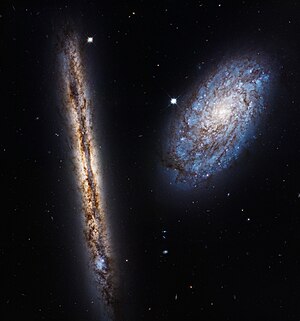NGC 4298
| Galaxie NGC 4298 | |
|---|---|
(c) ESA/Hubble, CC BY 4.0 | |
| NGC 4302 & NGC 4298, Hubble-Weltraumteleskop | |
| AladinLite | |
| Sternbild | Haar der Berenike |
| Position Äquinoktium: J2000.0, Epoche: J2000.0 | |
| Rektaszension | 12h 21m 32,7s[1] |
| Deklination | +14° 36′ 22″[1] |
| Erscheinungsbild | |
| Morphologischer Typ | SA(rs)c / HII[1][2] |
| Helligkeit (visuell) | 11,4 mag[2] |
| Helligkeit (B-Band) | 12,1 mag[2] |
| Winkelausdehnung | 3,2′ × 1,9′[2] |
| Positionswinkel | 140°[2] |
| Flächenhelligkeit | 13,2 mag/arcmin²[2] |
| Physikalische Daten | |
| Zugehörigkeit | Virgo-Cluster Messier 87-Gruppe NGC 4639-Gruppe LGG 289[1][3] |
| Rotverschiebung | 0.003786 ± 0.000013[1] |
| Radialgeschwindigkeit | 1135 ± 4 km/s[1] |
| Hubbledistanz vrad / H0 | (49 ± 3) · 106 Lj (14,9 ± 1,0) Mpc [1] |
| Geschichte | |
| Entdeckung | William Herschel |
| Entdeckungsdatum | 8. April 1784 |
| Katalogbezeichnungen | |
| NGC 4298 • UGC 7412 • PGC 39950 • CGCG 099-024 • MCG +03-32-007 • IRAS 12190+1452 • 2MASX J12213279+1436217 • VCC 483 • GC 2874 • H II 111 • h 1198 • LDCE 904 NED060 • HOLM 377A • KPG 332A • EVCC 412 | |
NGC 4298 ist eine regelmäßig geformte Spiralgalaxie mit ausgedehnten Sternentstehungsgebieten im Sternbild Haar der Berenike am Nordsternhimmel. Sie ist schätzungsweise 49 Millionen Lichtjahre von der Milchstraße entfernt und hat einen Durchmesser von etwa 45.000 Lj. Gemeinsam mit der Edge-on-Galaxie NGC 4302 bildet sie das stark gravitativ gebundene Galaxienpaar Holm 377 oder KPG 332. Unter der Katalognummer VCC 483 ist sie als Mitglied des Virgo-Galaxienhaufens eingetragen.
Im selben Himmelsareal befinden sich u. a. die Galaxien NGC 4262, IC 781, IC 3177 und IC 3238, einige Grad östlich die drei Riesengalaxien M87, M89 und M90, deren Schwerewirkung die Dynamik des Galaxienhaufens dominiert.
Das Objekt wurde am 8. April 1784 von dem Astronomen Wilhelm Herschel[4] mithilfe seines 18,7 Zoll-Spiegelteleskops entdeckt.
Weblinks
Einzelnachweise
Auf dieser Seite verwendete Medien
(c) ESA/Hubble, CC BY 4.0
This image displays the galaxies NGC 4302 — seen edge-on — and NGC 4298, both located 55 million light-years away. They were observed by Hubble to celebrate its 27th year in orbit.
The galaxy NGC 4298 is seen almost face-on, allowing us to see its spiral arms and the blue patches of ongoing star formation and young stars. In the edge-on disc of NGC 4302 huge swathes of dust are responsible for the mottled brown patterns, but a burst of blue to the left side of the galaxy indicates a region of extremely vigorous star formation.
The image is a mosaic of four separate captures from Hubble, taken between 2 and 22 January 2017, that have been stitched together to give this amazing field of view. Two different types of light emitted by the galaxies — visible and near-infrared — have been combined to give a rich and colourful image. This light was captured by Hubble’s Wide Field Camera 3, one of the telescope’s most advanced imaging instruments.



